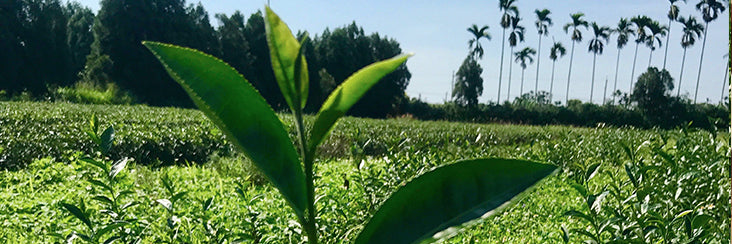
Jin Xuan GABA Black Tea | Eco-Cha Tea Club

This photo was taken last summer, shortly before harvesting this month's batch of Jin Xuan GABA Black Tea being shared with the Eco-Cha Tea Club. We took the photo when we visited our friend Mr. Xie to pick up the batch of tea that we shared last July. The difference between last July's and this month's batch of tea is simply in the processing. It's the same plot of naturally cultivated Jin Xuan tea trees, harvested one year later, and made into GABA Black Tea.
After years of honing his GABA tea making skills using Oolong processing methods, Mr. Xie decided to process this harvest as a GABA Black Tea for the first time. The entire harvest amounted to less than 20 kg, and by the time we found out about it, there was barely enough to be shared with our Tea Club members!
We also shared a batch of Mr. Xie's Black Tea made from a crop of his naturally farmed Wuyi tea plants with the Tea Club almost 3 years ago. We proclaimed that batch of Wuyi Black Tea to be the best Black Tea we had tasted to date. Well, now we have a very different, but equally special batch of Black Tea to share from this source that is a model of sustainability in naturally farmed specialty tea production.

In brief, his farming approach includes no use of fertilizers or irrigation, and he also does not cut or pull the weeds that grow in his plots of tea. Rather, he lets them grow to a certain height, and then pushes them over with a hand truck. With these methods, he is slowly transitioning plot after plot of tea in a low elevation region and consequently increasing the quality and value of the tea produced. This is what we find most inspiring in terms of having a sustainable impact on the local industry! In addition to this, he has experimented and developed innovative processing methods — one of which is GABA Tea.
The difference in processing methods between last July's batch and this month's batch of GABA TEA is how the leaves were oxidized. In Oolong Tea making, the leaves are tumbled slowly for 2-3 hours in large bamboo cylinders intermittently between long resting periods inside oxygen-free tanks. Then they undergo tumble heating to cease the oxidation process and fix the composition of the leaves.
In making Black Tea, the leaves are not tumbled, but rather they are rigorously pressed and rolled, after up to two days of transformation inside oxygen-free tanks, with intermittent shuffling only. This pressure rolling breaks down the fibers and cell walls in the leaves, exposing and mixing the compounds in the sap, resulting in a more thorough transformation in the oxidation process. They are then dried and gently rolled to fix them in their curled shape.
The flavor profiles that result from these variations in the long, slow, curing processes are quite distinct, yet with the same underlying GABA character of a mildly sweet fruity character. We feel that this is a unique opportunity to offer two batches of tea made from the same plot of naturally farmed tea, only one year apart, with variations only in how the leaves were cured.

LET US KNOW!
We really want to know what you think! Leave your impressions or questions in the comment section below!
SUBSCRIBE!
If you enjoyed this post and would like to hear more about the specialty tea industry here in Taiwan, follow us on YouTube, Facebook, and Instagram and please subscribe to our newsletter. Subscribe now and get $5 off your first order!

